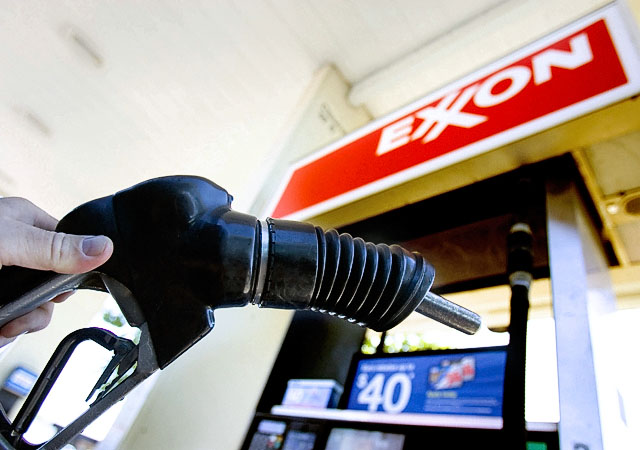As the bull market is nearing its sixth year, investors have to wonder where to invest for 2015 and beyond. Stocks have surged since the March 2009 panic selling bottom, and the year 2014 brought gains of 7.5% in the Dow Jones Industrial Average (DJIA) and 11.4% in the S&P 500 Index. While that index performance does not account for individual stock dividends, shares of Exxon Mobil Corp. (NYSE: XOM) closed out 2014 at $92.45 for a total return, including dividends, of -6%.
24/7 Wall St. has offered up an evaluation with a bullish and bearish case to see what lies ahead for Exxon Mobil and the other DJIA stocks in 2015 and beyond. One key consideration for the year ahead is that Exxon Mobil is under a major cloud due to hugely lower oil prices. Oil under $50 may be good for the consumer, but not for companies tied to oil and gas.
The fate of Exxon is almost identical to that of Chevron Corp. (NYSE: CVX). Chevron’s loss was 7% in 2014, versus a loss of about 6% for Exxon. Both are now expected to face very choppy earnings. Still, either Exxon or Chevron could become acquirers on weakness. We have already shown what oil under $50 means for companies and consumers alike. One thing that hurts in the Exxon comparison against Chevron is that Chevron has a dividend yield that is about 3.9%, versus closer to 3.2% for Exxon.
ALSO READ: The Bullish and Bearish Case for Verizon in 2015
Exxon Mobil is far less important on its own now at lower share prices in the DJIA index calculation, due to the Dow being a share price-weighted index. Its rank was recently shown to be 15 out 30 in weightings, with a weighting of 3.31%.
Oppenheimer only had a Perform rating on Exxon Mobil, but they have a great thought for the oil giant in a time of very low oil prices. Oppenheimer opined in the first week of 2015 that Exxon’s 3.8 billion treasury shares are now worth more than $350 billion, or 90% of its current market value. After having used its treasury shares in the past to acquire Mobil and XTO, Exxon’s two large deals were said to be triggered by a sharp drop in oil and gas prices, very similar to the current environment. Oppenheimer said:
Share buybacks improve per share metrics while storing value until used opportunistically in acquisitions. Since spinning off its downstream business is ruled out and organic growth is increasingly more difficult, we think a large acquisition is more likely. Even rivals are potential targets.
The problem in evaluating Exxon Mobil for a full year out is that analysts and economists are now worried that oil prices may remain quite low far beyond just 2015. Exxon also has to worry about many foreign operations in a world where geopolitical risk is high. Chevron recently suspended a huge project in Canada, while sanctions forced Exxon to exit in the Russian arctic. Exxon Mobil’s 25-year energy outlook also keeps oil as a relevant mix in energy for quite some time.
ALSO READ: The Bullish and Bearish Case for Procter & Gamble in 2015
Prior to the latest drop in oil, Exxon Mobil was among the most profitable companies in the world. Whether that can remain in place remains to be seen. The good news is that it is vertically integrated in all aspects of the oil and gas business, but that may the bad news as well.
After it lost 6% in 2014, analysts now have a consensus price target for Exxon Mobil of about $98. At $92.45 for the end of 2014, that implies upside of 9%, if you include that dividend yield of about 3.2%. A year ago, analysts expected Chevron to gain almost 6%, rather than turn in a loss of 7%. The expectation a year ago for Exxon Mobil was that it would lose 4.2% or so, versus the 6% loss.
There are many what-if scenarios and discussions that analysts and workers in the oil patch have under consideration at the moment. It seems hard to ignore the noise, but the magnetic pull may be simple enough — if oil stabilizes and recovers, then Exxon Mobil (and Chevron as well) likely will be treated much better by investors. That being said, it seems hard to get too excited if a crystal ball told you that the drop in oil was far from over.
ALSO READ: The Bullish and Bearish Case for Merck in 2015
100 Million Americans Are Missing This Crucial Retirement Tool
The thought of burdening your family with a financial disaster is most Americans’ nightmare. However, recent studies show that over 100 million Americans still don’t have proper life insurance in the event they pass away.
Life insurance can bring peace of mind – ensuring your loved ones are safeguarded against unforeseen expenses and debts. With premiums often lower than expected and a variety of plans tailored to different life stages and health conditions, securing a policy is more accessible than ever.
A quick, no-obligation quote can provide valuable insight into what’s available and what might best suit your family’s needs. Life insurance is a simple step you can take today to help secure peace of mind for your loved ones tomorrow.
Click here to learn how to get a quote in just a few minutes.
Thank you for reading! Have some feedback for us?
Contact the 24/7 Wall St. editorial team.




